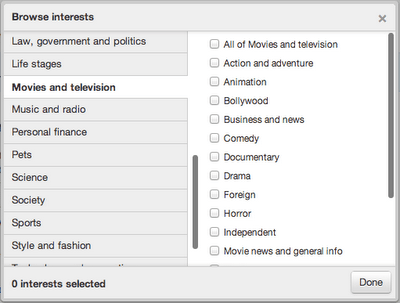Today featured a rather large announcement from Twitter regarding the future of their advertising product. According to multiple sources the announcements hit the wire today. I was at Twitter HQ in San Francisco just a few days ago and the Twitter Interest Graph was a featured topic of discussion. I just received the green light to discuss publicly from Twitter today, so here we go.
Now that the news has been unveiled, let’s take a deeper look at the Twitter Interest Graph and it’s potential impact for our clients. With 140 million users and strong international growth, further developing their ad platform was an obvious next step to drive increased value and offer additional opportunities to monetize their brand relationships.
Currently, the promoted tweets product was focused primarily on amplifying messages to users who were either already following a particular brand or a similar association as deemed by Twitter. Now by introducing the ability to target promoted tweets via other factors such as location and now interests, this opens up the landscape for brands to capitalize on growth and awareness goals that were simply not feasible until now.
An example of this would be American Airlines. Currently, AA could use a promoted tweet to target it’s 415,000 followers or people deemed similar by Twitter. Now, AA could essentially target new users based on interests tied to travel or destinations.
Google has it’s Google Knowledge Graph, Facebook it’s Social Graph and now Twitter has it’s Twitter Interest Graph. This graph, based on 25 top level and 300+ second level “interest categories” in addition to custom interest segments, uses asymmetrical real-time signals by users to drive the correlation with a users interests. In layman’s terms, Facebook shows a direct relationship between an interest and a user via a Like. Twitter takes other signals such as who an individual follows as well as your retweets to make associations of interest. This is also an extension of the logic used by the “who to follow” suggestions on your Twitter homepage.
From an earned media perspective, this definitely changes the game when it comes to driving value from Twitter. I cannot go into the details of the models discussed, but know that based on actual Twitter data the value of a campaign over the course of multiple years is extremely positive.
From a data standpoint, it is still unclear how this data will extend beyond the ad platform. With Facebook’s social graph, we have access to 180 points of data if authorized by the user that includes interest level data. This is incredibly powerful information to create highly relevant experiences and spark action on behalf of a user. As it stands now, and this could change as the graph evolves but today, the data is primarily tied to insights associated with paid campaigns.
Example of Facebook’s Social Graph data points
This is a great next step for Twitter as it continues to evolve it’s platform from simple utility for brands to becoming a major factor in not only impacting real-time and topical events, but harnessing the true power of it’s 140 million users and more closely associate brand goals with better targeting options to truly maximize opportunities.
Follow Tom Edwards @BlackFin360






